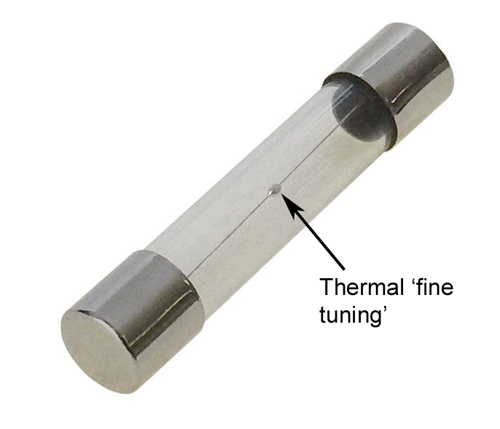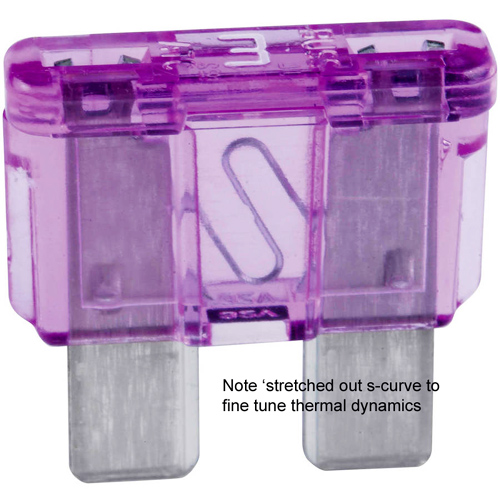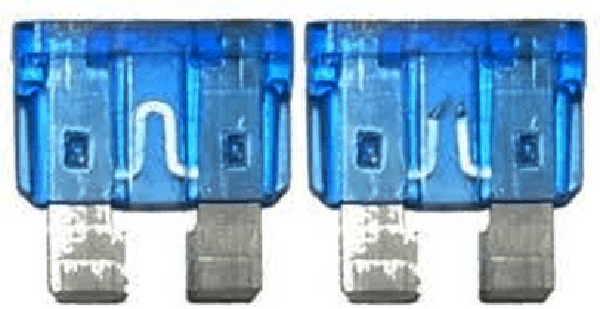 |
Matronics Email Lists
Web Forum Interface to the Matronics Email Lists
|
| View previous topic :: View next topic |
| Author |
Message |
nuckolls.bob(at)aeroelect
Guest
|
 Posted: Tue Jun 30, 2020 2:00 pm Post subject: Minimum length of fusible link wire segment Posted: Tue Jun 30, 2020 2:00 pm Post subject: Minimum length of fusible link wire segment |
 |
|
At 07:18 PM 6/19/2020, you wrote:
| Quote: | Bob, in a recent post you state that there is a 9-inch rule of
thumb minimum length for fusible link wire segments. Could you
explain the physics behind that, please?
Pat |
Sorry to take so long on this . . . it took a few
miles of 'asphalt engineering' to figure out how best
to explain it. I THINK I've got a way . . . let's
give it a try . . .
Fusible link performance, indeed performance of any
fusible circuit protective device is tightly bound
to the fact that most electrical conductors have
a positive temperature coefficient of resistance.
This means, it's resistance rises with temperature
of the conductor.
The rate of temperature rises is a
function of power (watts) dissipated in the
conductor mass which is the product of current
(amps) times resistance (ohms). Consider a piece
of wire, any gage, hanging out in space with some
current flowing through it.
Here's a 22AWG wire that has been happily
carrying 20A for some time. Note that I
attached a thermocouple to the sample wire
out in the middle of the rather significant
free span. Suppose I conducted this experiment
with, say a 1" piece of wire? How might we
guess that center-span's rate-of-rise would
differ for the two cases?
http://aeroelectric.com/Pictures/Wire/22AWG_20A.pdf
It's intuitive that heat generated in the
wire is conducted to the ends. Rate of rise
and temp equilibrium is influenced by sinking
effects of the terminals and radiation into
surrounding air. It's easy to deduce that a
short piece of wire is more resistant to
fusing than a longer one.
As a practical matter, the opening of an
electrically fusible segment tends to 'center up'
on the span. This is seen in the pictures of fuses
attached. As temperature begins to rise, heat
is generated all across the span and conducted
in both directions from any single point. The
CENTER of the span is least able to reject heat
to it's adjacent mass . . . it's getting warmed
up from both directions and also rising the fastest
due to effects of positive temperature coefficient.
Rising resistance increases electrical power dissipated
at that location more rapidly than anywhere else along
the span. Hence the temperature rise is regenerative
. . . the hotter it gets, the faster it warms up.
How long does this take? Complex question depending
on a constellation of conditions. Fuse and
breaker manufacturers work diligently to achieve
predictable performance in their products.
Here's a well written piece that explains the
thermal fiddling necessary to achieve predictable
i.e. fast versus slow blowing characteristic in fuses.
How about that little fly-spec of heat sink material
in the slow blo cartridge fuse?
https://tinyurl.com/ybkndmrc
It easy to see that control of the environment
surrounding the fusible event is critical.
A fusible link is in the 'HULK' family
of protective devices. Like its cousins,
the ANL, MANL and similar 'current limiters',
none are suited to the protection of the
more pedestrian appliance feeders. The
fusible link is SLOW and intended to clear
major faults (HUNDREDS+ AMPS) in the system
bus structure while maintaining a robust
indifference to rather severe transient overload.
Unlike our little plastic ATC friends that
can be 'hammered' into lower operating
currents by repeated excursions close to
but still short of their ratings.
Getting back to your question: Would a 6"
piece of fusible link fail to function?
How about a 1" piece? Probably not. They're
still the weakest link in the faulted pathway.
I am GUESSING that 9" figure is probably some
fusible link designer's 'happy place' for repeating
the in-service design goals he was working with.
Or perhaps it's a legacy hand-over from an automotive
industry specification.
In any case, wanting to shorten 'em up a tad is
not seriously significant to our task. My own
'happy place' would be 6". Hope this helps . . .
Bob . . .
| | - The Matronics AeroElectric-List Email Forum - | | | Use the List Feature Navigator to browse the many List utilities available such as the Email Subscriptions page, Archive Search & Download, 7-Day Browse, Chat, FAQ, Photoshare, and much more:
http://www.matronics.com/Navigator?AeroElectric-List |
|
| Description: |
|
| Filesize: |
43.95 KB |
| Viewed: |
2193 Time(s) |

|
| Description: |
|
| Filesize: |
122.02 KB |
| Viewed: |
2193 Time(s) |

|
| Description: |
|
| Filesize: |
61.26 KB |
| Viewed: |
2193 Time(s) |

|
| Description: |
|
| Filesize: |
26.95 KB |
| Viewed: |
2193 Time(s) |

|
|
|
| Back to top |
|
 |
nuckolls.bob(at)aeroelect
Guest
|
 Posted: Sat Jul 04, 2020 3:15 pm Post subject: Minimum length of fusible link wire segment Posted: Sat Jul 04, 2020 3:15 pm Post subject: Minimum length of fusible link wire segment |
 |
|
At 12:48 PM 7/4/2020, you wrote:
| Quote: | Thanks for this, Bob. That such a little blob of solder can have such a big effect is fascinating.
Pat |
Yeah . . . we don't know how 'big' big is but
intuitively we know that the effect is not
zero.
Similarly, the term SLOW BLOW for describing
fuse behavior is also non-quantified. Generally
speaking, we understand that selecting
a 'slow blow' version of the same kind of
fuse is something to try if we think that
we're seeing nuisance trips due to momentary
transients. Those transients may not be
very intense or long . . . perhaps just
repetitive. We studied the effects of
thermal 'hammering' in the 811HB
incident.
There are literally hundreds of variation
on the details of fuse behaviors. Our
favorite ATC plastics are fairly robust and
when used in automobiles, they are generally
waaayyy bigger than the normal current flow
in the circuit . . . perhaps 2 to 5x the
the normal current flow.
Check out the selection guide chart on
page 8 of this document:
https://tinyurl.com/ydfptnpu
This is a tiny fraction of functionality
to be considered when choosing circuit
protection TIGHTLY tailored to an
application.
Fuses in our cars and houses are NOT
tightly tailored to any application
beyond the protection of wires. For
low risk, convenient operation devoid
of nuisance trips we're encouraged to
take a similar approach to sizing wire
and circuit protection in our airplanes.
While boring holes in the sky, concerns
for keeping power on the far end of
your appliance feeders should occupy
no more of your thoughts than the size
of your prop bolts!
It would be interesting to see the I(squared)R
plots for that fuse with and without the
little glob in the middle. Still more interesting
to see the system requirements that were
satisfied by that final fuse design!
Bob . . .
| | - The Matronics AeroElectric-List Email Forum - | | | Use the List Feature Navigator to browse the many List utilities available such as the Email Subscriptions page, Archive Search & Download, 7-Day Browse, Chat, FAQ, Photoshare, and much more:
http://www.matronics.com/Navigator?AeroElectric-List |
|
|
|
| Back to top |
|
 |
|
|
You cannot post new topics in this forum
You cannot reply to topics in this forum
You cannot edit your posts in this forum
You cannot delete your posts in this forum
You cannot vote in polls in this forum
You cannot attach files in this forum
You can download files in this forum
|
Powered by phpBB © 2001, 2005 phpBB Group
|






